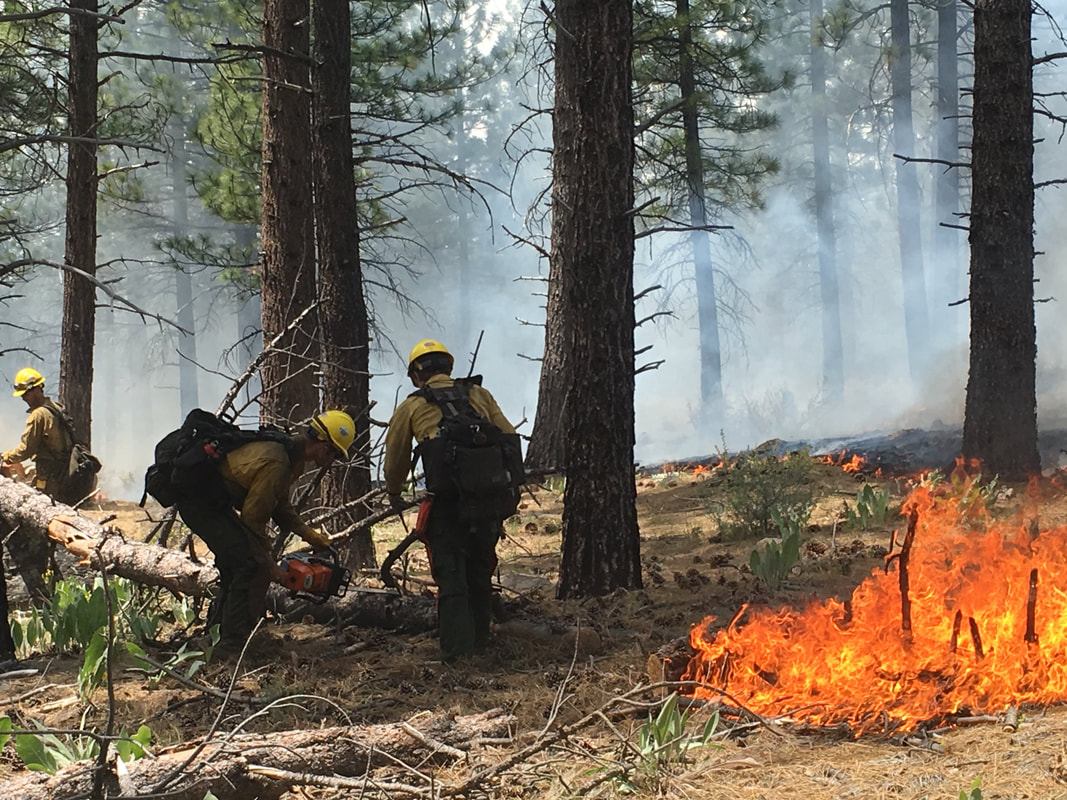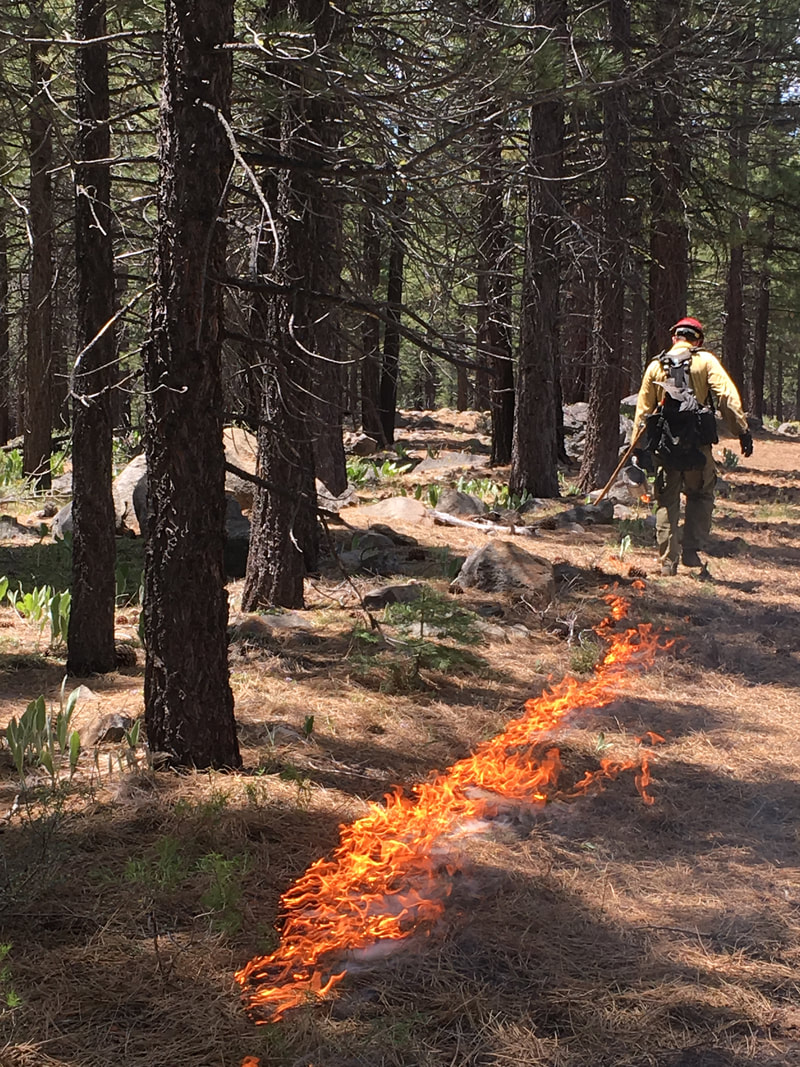
Sierraville, Calif. – Green Forest Service wildland fire engines mobilized with lights flashing down a smoke-filled forest road to a report of a vegetation fire near Little Truckee Summit. Truckee Hotshots filed out of the crew buggies, grabbed their tools, and prepared drip torches. The vegetation fire that these crews prepared to engage, is in fact, not a wildfire. Fire managers set a prescribed fire under safe conditions to provide Tahoe National Forest East Zone wildland fire engine crews from Truckee and Sierraville and the Truckee Hotshots a valuable training opportunity.
Crews utilized this live fire to train and demonstrate their proficiency with wildfire suppression tactics in preparation for the fire season. “We train like we fight fire,” said Shawn Burt, Sierraville Ranger District Battalion Chief. Training together and being proficient with tactics and equipment improves the effectiveness and safety of responses.
“The value in training under live fire conditions is that it gives the crews a better perspective to learn more about fire behavior. They observe up close, how fire interacts with the landscape and how it responds to fuels, weather, and topography. Crews can then adjust their tactics in real time accordingly, to learn how they can better protect life, property, and resources when an actual wildfire ignites,” explained Joe Griffin, Truckee Ranger District Battalion Chief.
A secondary benefit to this carefully planned live fire training is that it allowed Fuels managers to reintroduce fire into the ecosystem within the prescribed burn unit. Prescribed fire increases forest resiliency by reducing the accumulation of fuels, which improves forest health.
Fire managers and resources prepare year round to respond to natural and human caused wildfire, as well as other all-risk incidents, that occur every year in the Tahoe National Forest and nationally. On the East Zone, in Truckee and Sierraville, a total of four prevention techs in patrol trucks, five engine crews and the Truckee Hotshots conduct training that enables crews to effectively and safely respond, manage, and assist with all-risk incidents. This provides greater protection for public safety and natural resources.
In addition to the live fire training at Little Truckee Summit, wildland fire crews trained under live fire conditions for all-risk incidents at the Grass Valley Emergency Command Center. Practicing with vehicle and dumpster fires enhance their capabilities with SCBA (Self-Contained Breathing Apparatus) use when responding to incidents such as these.
Firefighting is inherently dangerous and all fire personnel are provided with basic medical training. Firefighters may also be Emergency Medical Technicians. Fire crews frequently practice scenarios to be able to assist during a medical incident both on and off the fireline.
Firefighters attend classes and refreshers covering subjects such as weather and fire behavior, chainsaw operation, portable pumps to provide water to fires, maps and compass, radio communication, and leadership. A culture of learning is fostered by reviewing lessons learned from past incidents, as well as studying fires where a firefighter fatality occurred.
Forest Service fire crews cross-train with other local Fire agencies to improve communication and efficiency during mutual aid responses. USFS fire crews are a national resource and respond to local incidents as well as national ones where they will fight fire alongside other agencies all over the country.
“Train like your life depends on it.” is a statement that holds true for the Tahoe National Forest firefighters and fire managers so that after responding to any type of incident, from wildfires to vehicle and dumpster fires, and medical incidents, everyone goes home. The public can also help their community and firefighters by preparing for wildfire and practicing responsible fire safety. For more info, check out readyforwildfire.org and preventwildfireca.org.
Media Inquiries can be directed to: Meredith Anello, [email protected], (530) 587-3558 #242
For more information about the Tahoe National Forest, go to www.fs.usda.gov/tahoe. Join the conversation by following us on Twitter at twitter.com/Tahoe_NF and Facebook at www.facebook.com/TahoeNF.
###
Crews utilized this live fire to train and demonstrate their proficiency with wildfire suppression tactics in preparation for the fire season. “We train like we fight fire,” said Shawn Burt, Sierraville Ranger District Battalion Chief. Training together and being proficient with tactics and equipment improves the effectiveness and safety of responses.
“The value in training under live fire conditions is that it gives the crews a better perspective to learn more about fire behavior. They observe up close, how fire interacts with the landscape and how it responds to fuels, weather, and topography. Crews can then adjust their tactics in real time accordingly, to learn how they can better protect life, property, and resources when an actual wildfire ignites,” explained Joe Griffin, Truckee Ranger District Battalion Chief.
A secondary benefit to this carefully planned live fire training is that it allowed Fuels managers to reintroduce fire into the ecosystem within the prescribed burn unit. Prescribed fire increases forest resiliency by reducing the accumulation of fuels, which improves forest health.
Fire managers and resources prepare year round to respond to natural and human caused wildfire, as well as other all-risk incidents, that occur every year in the Tahoe National Forest and nationally. On the East Zone, in Truckee and Sierraville, a total of four prevention techs in patrol trucks, five engine crews and the Truckee Hotshots conduct training that enables crews to effectively and safely respond, manage, and assist with all-risk incidents. This provides greater protection for public safety and natural resources.
In addition to the live fire training at Little Truckee Summit, wildland fire crews trained under live fire conditions for all-risk incidents at the Grass Valley Emergency Command Center. Practicing with vehicle and dumpster fires enhance their capabilities with SCBA (Self-Contained Breathing Apparatus) use when responding to incidents such as these.
Firefighting is inherently dangerous and all fire personnel are provided with basic medical training. Firefighters may also be Emergency Medical Technicians. Fire crews frequently practice scenarios to be able to assist during a medical incident both on and off the fireline.
Firefighters attend classes and refreshers covering subjects such as weather and fire behavior, chainsaw operation, portable pumps to provide water to fires, maps and compass, radio communication, and leadership. A culture of learning is fostered by reviewing lessons learned from past incidents, as well as studying fires where a firefighter fatality occurred.
Forest Service fire crews cross-train with other local Fire agencies to improve communication and efficiency during mutual aid responses. USFS fire crews are a national resource and respond to local incidents as well as national ones where they will fight fire alongside other agencies all over the country.
“Train like your life depends on it.” is a statement that holds true for the Tahoe National Forest firefighters and fire managers so that after responding to any type of incident, from wildfires to vehicle and dumpster fires, and medical incidents, everyone goes home. The public can also help their community and firefighters by preparing for wildfire and practicing responsible fire safety. For more info, check out readyforwildfire.org and preventwildfireca.org.
Media Inquiries can be directed to: Meredith Anello, [email protected], (530) 587-3558 #242
For more information about the Tahoe National Forest, go to www.fs.usda.gov/tahoe. Join the conversation by following us on Twitter at twitter.com/Tahoe_NF and Facebook at www.facebook.com/TahoeNF.
###



